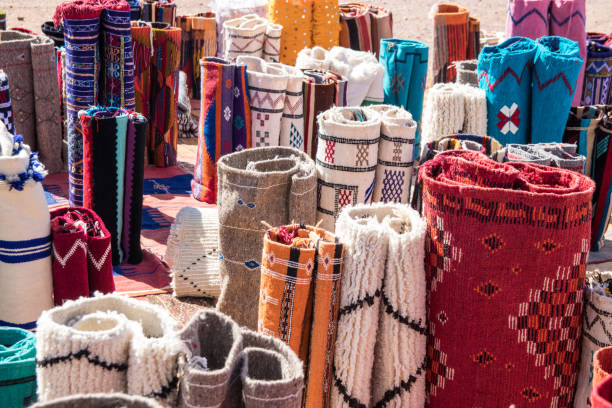Morocco, a country in North Africa, has become a trendy tourist destination. The tribal minimalist and geometric patterns of the region are also stylish for home decor.
Some inferior production centers have taken shortcuts to get goods to the market faster and more cheaply.
Although many high-quality decorative textiles are being produced in Morocco, the poor ones create disasters and tarnish the reputation of the weaving traditions of the area.
How to identify the signs of poor production.
MOROCCAN FIBER SHORTCUTS
The higher-altitude sheep in Morocco produce a higher-quality, more robust wool than the lower-altitude sheep.
Some operations looking to reduce costs may purchase lower-quality wool and mix it with natural and synthetic fibers to increase its strength so they can weave a rug.
In the first few months after purchase, a good quality Moroccan shag rug with a longer pile may shed due to the release of short fibers and loose staples from the shearing procedure.
Wool of higher quality and yarns produced with it will stop shedding relatively quickly. Poorer quality wool will shed throughout its lifetime, as the fibers are not strong enough.
You should also check the rug for months if you own a Moroccan rug that sheds heavily. These “shortcuts” are rugs that do not undergo a thorough cleaning during production. This increases the risk of moth larvae and eggs entering your home.
Visit Moths Bugs & Rugs for tips on inspecting your rugs and carpets for moths and what you should know.
MOROCCAN Dyeing SHORTCUTS
In the last few years, rugs from this area have been a source of complaints about strong, offensive smells. Based on our experience in the rug shop and the stories shared by readers on my Rug Chick Blog about their Moroccan rug “awful smell” stories, we have found that these rugs are often heavily faded compared to the reverse side. These rugs tend to have embroidery or sumac stitching.
The odors are caused by either the chemical bleaching after the sale of the rugs or the heavy use of chemicals (sometimes toxic) in the dyeing processes of the fibers used.
The process to create a more distressed, softer look is by spraying bleach solution on the face of the rugs and setting them out in the sun. These rugs can be identified by looking at the back to see if the colors do not match.
A spill on the front of the rug (or a cleaning method that is not done properly) can cause the color to be absorbed from the back, which will unintentionally alter the appearance. The bleach needed to cause this type of fading is toxic, and the smell can linger for a long time.
Other foul smells can be a bigger problem than bleach.
Dan Driscoll (founder of The Anou, a network of weaving and artist co-operatives based in Morocco) conducted field research on some complaints about noxious smells and found that many major suppliers are using chemicals such as formaldehyde to speed up the dyeing process.
Dan writes about this in his blog: a href= “https://helloanou.wordpress.com/2017/05/15/the-atlas-wool-supply co. building a modern craft material market in Morocco/”>Click Here for Full Article. Dan has written about this on his blog: Click here for the Full Article.
These two bad dyers make the worst rugs that come out of Morocco. When shopping for Moroccan rugs, be sure to check if the rug has any smells.
Rug cleaners can identify these problem rugs when their clients have spilled plain water, and an ink stain appears. The color may have been completely removed during the cleaning process. If you don’t know the flaws in the dyeing process, these rugs can turn a rug-washing floor into a dye soup.
RUG CLEANERS – PROTECT YOU, YOUR TEAM AND CLIENTS
When it comes to Moroccan rugs, bad rugs are bad. A standard fiber or dye test can alert you to serious quality control problems. Do not ignore the basics.
Inspecting the rug’s front and back can also tell you if it has been chemically cleaned.
You can tell by your nose if you are in a serious situation. These rugs can cause severe allergic reactions to their owners. If you receive a call from someone who has just purchased a Moroccan rug that smells bad, suggest that they remove it until they decide whether to return it as a defective product.
Take the appropriate precautions if you suspect that the problem is formaldehyde.
Give them tips to inspect quality if you are a designer or customer looking for Moroccan rugs. Use your thumbnail to scratch fibers and see if they break easily. This is a sign that the wool is bad. Test dye quality with a wet handkerchief. Use the “sniff” test to determine if there is anything odd about the rug.

